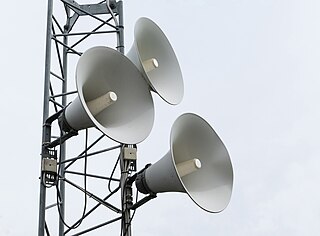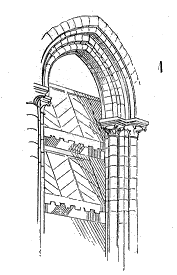
Language is a structured system of communication that consists of grammar and vocabulary. It is the primary means by which humans convey meaning, both in spoken and written forms, and may also be conveyed through sign languages. Human language is characterized by its cultural and historical diversity, with significant variations observed between cultures and across time. Human languages possess the properties of productivity and displacement, which enable the creation of an infinite number of sentences, and the ability to refer to objects, events, and ideas that are not immediately present in the discourse. The use of human language relies on social convention and is acquired through learning.

A loudspeaker is an electroacoustic transducer that converts an electrical audio signal into a corresponding sound. A speaker system, also often simply referred to as a speaker or loudspeaker, comprises one or more such speaker drivers, an enclosure, and electrical connections possibly including a crossover network. The speaker driver can be viewed as a linear motor attached to a diaphragm which couples that motor's movement to motion of air, that is, sound. An audio signal, typically from a microphone, recording, or radio broadcast, is amplified electronically to a power level capable of driving that motor in order to reproduce the sound corresponding to the original unamplified electronic signal. This is thus the opposite function to the microphone; indeed the dynamic speaker driver, by far the most common type, is a linear motor in the same basic configuration as the dynamic microphone which uses such a motor in reverse, as a generator.

Thai, or Central Thai, is a Tai language of the Kra–Dai language family spoken by the Central Thai people, Mon in Central Thailand and the vast majority of Thai Chinese enclaves throughout the country. It is the sole official language of Thailand.

A megaphone, speaking-trumpet, bullhorn, blowhorn, or loudhailer is usually a portable or hand-held, cone-shaped acoustic horn used to amplify a person's voice or other sounds and direct it in a given direction. The sound is introduced into the narrow end of the megaphone, by holding it up to the face and speaking into it, and the sound waves radiate out the wide end. A megaphone increases the volume of sound by increasing the acoustic impedance seen by the vocal cords, matching the impedance of the vocal cords to the air, so that more sound power is radiated. It also serves to direct the sound waves in the direction the horn is pointing. It somewhat distorts the sound of the voice because the frequency response of the megaphone is greater at higher sound frequencies.
A pastor is the leader of a Christian congregation who also gives advice and counsel to people from the community or congregation. In Lutheranism, Catholicism, Eastern Orthodoxy, Oriental Orthodoxy and Anglicanism, pastors are always ordained. In Methodism, pastors may be either licensed or ordained.

Listening is giving attention to a sound. When listening, a person hears what others are saying and tries to understand what it means.

A pulpit is a raised stand for preachers in a Christian church. The origin of the word is the Latin pulpitum. The traditional pulpit is raised well above the surrounding floor for audibility and visibility, accessed by steps, with sides coming to about waist height. From the late medieval period onwards, pulpits have often had a canopy known as the sounding board, tester or abat-voix above and sometimes also behind the speaker, normally in wood. Though sometimes highly decorated, this is not purely decorative, but can have a useful acoustic effect in projecting the preacher's voice to the congregation below, especially prior to the invention of modern audio equipment. Most pulpits have one or more book-stands for the preacher to rest his bible, notes or texts upon.
In literature and writing, stylistically elements are the use of any of a variety of techniques to give an auxiliary meaning, ideas, or feeling to the literalism or written.

A public address system is an electronic system comprising microphones, amplifiers, loudspeakers, and related equipment. It increases the apparent volume (loudness) of a human voice, musical instrument, or other acoustic sound source or recorded sound or music. PA systems are used in any public venue that requires that an announcer, performer, etc. be sufficiently audible at a distance or over a large area. Typical applications include sports stadiums, public transportation vehicles and facilities, and live or recorded music venues and events. A PA system may include multiple microphones or other sound sources, a mixing console to combine and modify multiple sources, and multiple amplifiers and loudspeakers for louder volume or wider distribution.

The Rektoratskirche St. Karl Borromäus, commonly called the Karlskirche, is a Baroque church located on the south side of Karlsplatz in Vienna, Austria. Widely considered the most outstanding baroque church in Vienna, as well as one of the city's greatest buildings, the church is dedicated to Saint Charles Borromeo, one of the great counter-reformers of the sixteenth century.
Nuisance is a common law tort. It means something which causes offence, annoyance, trouble or injury. A nuisance can be either public or private. A public nuisance was defined by English scholar Sir James Fitzjames Stephen as,
"an act not warranted by law, or an omission to discharge a legal duty, which act or omission obstructs or causes inconvenience or damage to the public in the exercise of rights common to all Her Majesty's subjects".

An abat-son is an architectural device constructed to reflect or direct sound in a particular direction. It consists of large louvers. The term is commonly used to refer to angled louvers in a bell tower or belfry designed to redirect sound or to prevent ingress of water.

The New York City Council is the lawmaking body of New York City in the United States. It has 51 members from 51 council districts throughout the five boroughs.
Language teaching, like other educational activities, may employ specialized vocabulary and word use. This list is a glossary for English language learning and teaching using the communicative approach.

The Church of Mariahilf is a Baroque parish church and the church of the Congregation of Saint Michael the Archangel in Vienna. It is located in Vienna's 6th district (Mariahilf).

This is a glossary of jazz and popular music terms that are likely to be encountered in printed popular music songbooks, fake books and vocal scores, big band scores, jazz, and rock concert reviews, and album liner notes. This glossary includes terms for musical instruments, playing or singing techniques, amplifiers, effects units, sound reinforcement equipment, and recording gear and techniques which are widely used in jazz and popular music. Most of the terms are in English, but in some cases, terms from other languages are encountered.
In linguistics, a backchanneling during a conversation occurs when one participant is speaking and another participant interjects responses to the speaker. A backchannel response can be verbal, non-verbal, or both. Backchannel responses are often phatic expressions, primarily serving a social or meta-conversational purpose, such as signifying the listener's attention, understanding, sympathy, or agreement, rather than conveying significant information. Examples of backchanneling in English include such expressions as "yeah", "OK", "uh-huh", "hmm", "right", and "I see".

Lutheran Church of Budavár is the oldest Lutheran church of Buda. It was built in 1895 at Vienna Gate Square in the 1st District of Budapest. The first church for the Lutherans of Buda was built by Maria Dorothea, third wife of Palatine Joseph, in 1846, at hu:Dísz tér. The site was taken over by the Ministry of Defence, so a new church was built near Vienna Gate.

The Cathedral Basilica of the Assumption of Our Lady is a Catholic church that serves as cathedral basilica in Győr, Hungary, being the seat of the Diocese of Győr.

The Cathedral Basilica of St. Stephen the King also called Székesfehérvár Cathedral is the name given to a religious building of the Catholic Church in Hungary which serves as the cathedral of the city of Székesfehérvár. It is therefore the seat of the Diocese of Székesfehérvár, which was created in 1777 by bull "In universa gregis" of Pope Pius VI.















